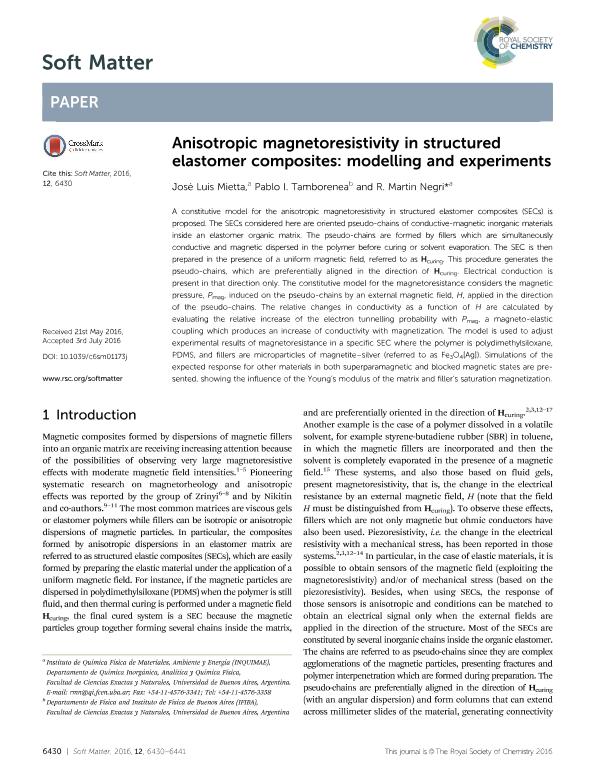Mostrar el registro sencillo del ítem
dc.contributor.author
Mietta, J. L.
dc.contributor.author
Tamborenea, Pablo Ignacio

dc.contributor.author
Negri, Ricardo Martin

dc.date.available
2018-06-08T16:42:26Z
dc.date.issued
2016-07
dc.identifier.citation
Mietta, J. L.; Tamborenea, Pablo Ignacio; Negri, Ricardo Martin; Anisotropic magnetoresistivity in structured elastomer composites: modelling and experiments; Royal Society of Chemistry; Soft Matter; 12; 7-2016; 6430-6441
dc.identifier.issn
1744-683X
dc.identifier.uri
http://hdl.handle.net/11336/47871
dc.description.abstract
A constitutive model for the anisotropic magnetoresistivity in structured elastomer composites (SECs) is proposed. The SECs considered here are oriented pseudo-chains of conductive-magnetic inorganic materials inside an elastomer organic matrix. The pseudo-chains are formed by fillers which are simultaneously conductive and magnetic dispersed in the polymer before curing or solvent evaporation. The SEC is then prepared in the presence of a uniform magnetic field, referred to as <strong>H</strong><small><sub>curing</sub></small>. This procedure generates the pseudo-chains, which are preferentially aligned in the direction of <strong>H</strong><small><sub>curing</sub></small>. Electrical conduction is present in that direction only. The constitutive model for the magnetoresistance considers the magnetic pressure, <em>P</em><small><sub>mag</sub></small>, induced on the pseudo-chains by an external magnetic field, <em>H</em>, applied in the direction of the pseudo-chains. The relative changes in conductivity as a function of <em>H</em> are calculated by evaluating the relative increase of the electron tunnelling probability with <em>P</em><small><sub>mag</sub></small>, a magneto-elastic coupling which produces an increase of conductivity with magnetization. The model is used to adjust experimental results of magnetoresistance in a specific SEC where the polymer is polydimethylsiloxane, PDMS, and fillers are microparticles of magnetite?silver (referred to as Fe<small><sub>3</sub></small>O<small><sub>4</sub></small>[Ag]). Simulations of the expected response for other materials in both superparamagnetic and blocked magnetic states are presented, showing the influence of the Young´s modulus of the matrix and filler´s saturation magnetization.
dc.format
application/pdf
dc.language.iso
eng
dc.publisher
Royal Society of Chemistry

dc.rights
info:eu-repo/semantics/openAccess
dc.rights.uri
https://creativecommons.org/licenses/by-nc-sa/2.5/ar/
dc.subject
Composites
dc.subject
Magnetoresistivity
dc.subject.classification
Astronomía

dc.subject.classification
Ciencias Físicas

dc.subject.classification
CIENCIAS NATURALES Y EXACTAS

dc.title
Anisotropic magnetoresistivity in structured elastomer composites: modelling and experiments
dc.type
info:eu-repo/semantics/article
dc.type
info:ar-repo/semantics/artículo
dc.type
info:eu-repo/semantics/publishedVersion
dc.date.updated
2018-06-01T13:56:05Z
dc.journal.volume
12
dc.journal.pagination
6430-6441
dc.journal.pais
Reino Unido

dc.journal.ciudad
CAMBRIDGE
dc.description.fil
Fil: Mietta, J. L.. Universidad de Buenos Aires. Facultad de Ciencias Exactas y Naturales. Departamento de Química Inorgánica, Analítica y Química Física; Argentina
dc.description.fil
Fil: Tamborenea, Pablo Ignacio. Universidad de Buenos Aires. Facultad de Ciencias Exactas y Naturales. Departamento de Física; Argentina. Consejo Nacional de Investigaciones Científicas y Técnicas. Oficina de Coordinación Administrativa Ciudad Universitaria. Instituto de Física de Buenos Aires. Universidad de Buenos Aires. Facultad de Ciencias Exactas y Naturales. Instituto de Física de Buenos Aires; Argentina
dc.description.fil
Fil: Negri, Ricardo Martin. Universidad de Buenos Aires. Facultad de Ciencias Exactas y Naturales. Departamento de Química Inorgánica, Analítica y Química Física; Argentina
dc.journal.title
Soft Matter

dc.relation.alternativeid
info:eu-repo/semantics/altIdentifier/doi/http://dx.doi.org/10.1039/C6SM01173J
dc.relation.alternativeid
info:eu-repo/semantics/altIdentifier/url/http://pubs.rsc.org/en/content/articlelanding/2016/sm/c6sm01173j#!divAbstract
Archivos asociados
